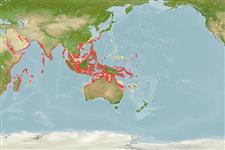分类 / Names
俗名 | 同种异名 | Catalog of Fishes(属, 种) | ITIS | CoL | WoRMS | Cloffa
Teleostei >
Eupercaria/misc (Various families in series Eupercaria) >
Caesionidae (Fusiliers) > Caesioninae
Etymology: Caesio: Latin, caesius, bluish-grey, 1835; it is the same name given to the silvery metal (Cs) (Ref. 45335).
More on author: Cuvier.
Environment: milieu / climate zone / depth range / distribution range
生态学
海洋 礁区鱼类; 非迁移的; 深度上下限 0 - 50 m (Ref. 402). 熱帶; 31°N - 28°S, 32°E - 167°E (Ref. 402)
Indo-West Pacific: Red Sea, Persian Gulf and East Africa to the Solomon Islands, north to southern Japan.
印度-西太平洋: 紅海 , 波斯灣而且東非到索羅門群島, 北至日本南部。
大小 / 重量 / 年龄
Maturity: Lm ? range ? - ? cm
Max length : 40.0 cm TL 雄鱼/尚未辨别雌雄; (Ref. 402)
背棘 (总数) : 10; 背的软条 (总数) : 13 - 15; 臀棘: 3; 臀鳍软条: 10 - 11. This species is distinguished by the following characters: a single postmaxillary process; D X, usually 14 soft rays; A III, usually 11soft rays; supratemporal band of scales generally interrupted at dorsal midline by a narrow scaleless zone; lateral line scales modally 49; scales above lateral line to dorsal -fin origin 7-10 (modally 8), below lateral line to anal-fin origin 14-19; predorsal scales 20-26; greatest body depth 2.2-3.1 in SL, head length 2.7-3.4 in SL; colour of body bluish, belly paler than upper sides; tips of caudal fin lobes, axil of pectoral fins, and upper base of pectoral fins black; caudal fin blue (except in juveniles where caudal fin and portions of caudal peduncle often yellow); pectoral, pelvic, and anal fins white to pale blue (pink or reddish after death); dorsal fin bluish (Ref. 68703, 90102).
蓝色的身体, 腹侧灰白的; 尾叶顶端,叶腋与胸鳍的上基底黑色。 稚鱼有黄色的尾部与黑色的顶端。 在颊上的 4-5 鳞片; 18-25个前背的鳞片; 覆有鳞片的背鳍与臀鳍。 上柄的鳞片列通常 10 或 11(9-13); 下柄的鳞片列通常 14 或 15.(13-15) 鳞片的前期暂时条纹被在背部中线的一个细无鳞片的区域中断。 对于 Baudelot 的结带的附着的基枕骨突起不存在。 后颚的突起单个; 颚骨的后端钝的。
Adults are found in coastal areas, mainly on or near coral reefs (Ref. 30573). They are more common along steep seaward reefs than in lagoons (Ref. 9710). They form large aggregations in midwater on upper edge of steep slopes and around patch reefs, often with other fusiliers (Ref. 90102). They feed on zooplankton. Are oviparous, with numerous, small pelagic eggs (Ref. 402).
发现于沿岸区域,主要在珊瑚礁上面或附近了。 (参考文献 30573) 更普遍沿着陡峭的临海礁石超过在舄湖中.(参考文献 9710) 在中层水域中形成鱼群并且吃浮游动物。 卵生的, 有很多的, 小型大洋性鱼类卵.(参考文献 402)
Life cycle and mating behavior
成熟度 | 繁殖 | 产卵场 | 卵 | 孕卵数 | 仔鱼
印度-西太平洋: 紅海 , 波斯灣而且東非到索羅門群島, 北至日本南部。
Carpenter, K.E., 1987. Revision of the Indo-Pacific fish family Caesionidae (Lutjanoidea), with descriptions of five new species. Indo-Pac. Fish. (15):56 p. (Ref. 1723)
世界自然保护联盟红皮书 (Ref. 130435: Version 2024-1)
人类利用
渔业: 低经济
工具
特别资料
下载 XML
网络资源
Estimates based on models
Preferred temperature (Ref.
123201): 24.7 - 29.2, mean 28.2 °C (based on 1494 cells).
Phylogenetic diversity index (Ref.
82804): PD
50 = 0.5020 [Uniqueness, from 0.5 = low to 2.0 = high].
Bayesian length-weight: a=0.01698 (0.00895 - 0.03223), b=3.09 (2.92 - 3.26), in cm total length, based on LWR estimates for this species & (Sub)family-body (Ref.
93245).
营养阶层 (Ref.
69278): 3.4 ±0.45 se; based on food items.
回复力 (Ref.
120179): 高度, 族群倍增时间少于 15个月 (Preliminary K or Fecundity.).
Fishing Vulnerability (Ref.
59153): Low to moderate vulnerability (30 of 100).
Nutrients (Ref.
124155): Calcium = 53.2 [35.4, 76.6] mg/100g; Iron = 0.708 [0.466, 1.023] mg/100g; Protein = 19 [18, 20] %; Omega3 = 0.138 [0.096, 0.196] g/100g; Selenium = 33.1 [21.1, 55.5] μg/100g; VitaminA = 99.1 [41.3, 244.0] μg/100g; Zinc = 1.1 [0.8, 1.5] mg/100g (wet weight);
